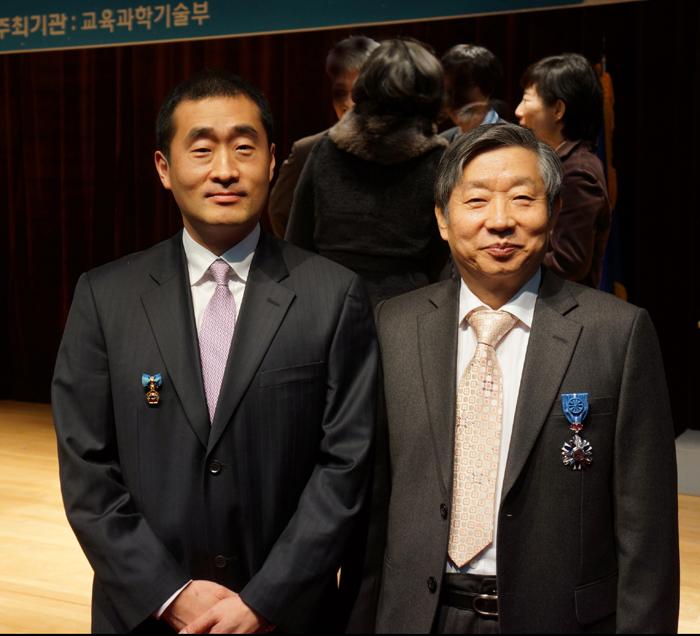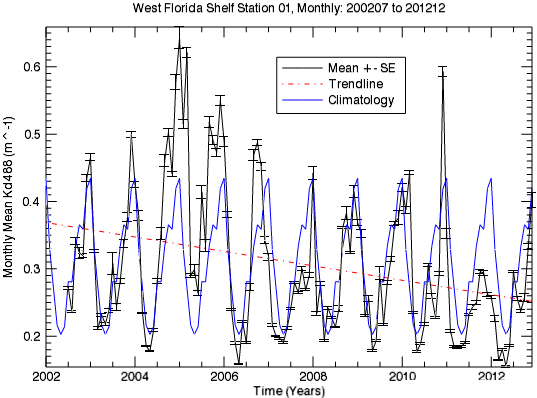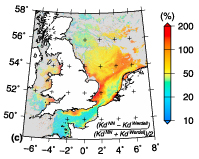

|
|
The 18th IOCCG Committee meeting took place in Québec City, Canada from 5 - 7 February 2013. The meeting was co-hosted by the Canadian Space Agency (CSA) and by Takuvik Joint International Laboratory, a partnership between Université Laval and CNRS (France). Representatives from all the major space agencies with an interest in ocean colour attended the meeting as well as research scientists from around the world. A nubmer of items were discussed including the progress of the current IOCCG working groups, contriubtions to the CEOS Ocean Colour Radiometry-Virtual Constellation, proposals for new IOCCG working groups, capacity building initiatives as well as the upcoming IOCS meeting (see below). The minutes of the meeting will be posted on theIOCCG website in due course. IOCCG-18 participants (click on image to enlarge).
The International Ocean Colour Science meeting (IOCS) is taking place in Darmstadt, Germany from 6 - 8 May 2013. Please see the Second Announcement flyer for details. All interested participants are requested to register using the on-line registration tool as soon as possible. Registration is free, but all participants must be registered in order to attend the meeting. There will be a number of interesting keynote presentations:
In addition there will be 12 splinter sessions chaired by prominent ocean colour scientists addressing a wide range of topical issues. Further details on all the splinter sessions can be found on the meeting website. These splinter sessions will provide an opportunity for extended dialogue and exchange of ideas about a specific topic, and will be open to all participants. Ocean colour research scientists are also encouraged to submit an abstract on their own research to be discussed during the poster presentation sessions. The deadline for submitting an abstract is 15 March 2013.
IOCCG Committee member, Dr. Yu-Hwan Ahn, of the Korea Ocean Satellite Center (KOSC/KIOST), was decorated by Korean government on 17 January 2013 for his excellent leadership in the development of the Geostationary Ocean Color Imager (GOCI). Korea launched GOCI, the first ocean colour satellite in a geostationary orbit, two years ago. Dr. Joo-Hyung Ryu of KOSC was also cited by Korean primary minister for his outstanding contribution to the GOCI project and GOCI ocean application activities. Three engineers of the Korea Aerospace Research Institute (KARI) were also decorated for the COMS satellite development.
 Drs. Joo-Hyung Ryu and Yu-Hwan Ahn after being decorated by the Korean Government for their contributions to the GOCI mission. The Korean government particularly acknowledged Dr. Ahn’s contribution as the main leader of the GOCI project for the development of the scientific mission, user requirements analysis, technical design review, scientific research achievement and the GDPS (GOCI Data Processing System) development. Furthermore, the establishment of the Korea Ocean Satellite Center (KOSC) in 2007 for GOCI data processing and public domain service, came to fruition under Dr. Ahn’s leadership. Since the launch of the GOCI, the KOSC manages the GOCI data operationally and carries out research for the monitoring of Korean waters to mitigate the effects of ocean disasters such as red- or green-tides, oil spills, sea ice or sea fog, as well as land applications (wildfire, volcanic eruption. yellow dust etc.).
There has been a great deal of interest in the videos from the IOCCG Summer Lecture Series (2-14 July 2012), as well as requests for electronic versions of the lectueres' presentations. We are therefore pleased to inform you that all the PowerPoint presentations from the summer training course are now available on the IOCCG website along with the videos. These can be downloaded from the Training & Education section of the IOCCG website at www.ioccg.org/training/lectures.html.
In order to discuss the preliminary results of these new developments a CoastColour User Consultation Meeting will be held back-to-back with the IOCCG International Ocean Colour Science meeting on 9 - 10 May 2013, in Darmstadt, Germany. This meeting will be conducted in cooperation with the SeaSWIR project which focusses on extreme turbid waters. Registration for the meeting is open through the CoastColour Website. |
This is a work in progress, with further improvements and an expanded product suite anticipated. See the full posting on the NASA Ocean Color Forum.
After 10 years of global observations by MODIS-Aqua, the monthly climatology data created by the NASA Ocean Biology Processing Group (OBPG) has been used in Giovanni as a climatology data baseline. Anomaly analysis enhances the detection of unusual events in any long-term data set, by comparing data from a selected period to the average of the data for a much longer period (i.e., "base period"). Several new data products are available from MODIS-Aqua, including normalized fluorescence line height (nFLH), CDOM index, absorption coefficients (acdm and aph), backscattering coefficient (bbp) and euphotic depth (Zeu). The MODIS-Aqua climatology data also provide remote-sensing reflectance data at several more wavelengths than were available from SeaWiFS. Giovanni’s anomaly analysis capability allows users to examine monthly anomalies, and any other time period up to a year in duration. For example, it is possible to average data over one season of a particular year, and compare this average to the climatological average for the corresponding months. Funding for support of ocean colour radiometry data in Giovanni is provided through the "Water Quality for Coastal and Inland Waters Project" from NASA. For more information, see the full article with example images at: http://1.usa.gov/WQB7mZ
Another system that provides climatological and long-term trends is a prototype Virtual Buoy System (VBS) that was established at the University of South Florida's College of Marine Science to provide long-term water quality data at pre-selected stations in the Gulf of Mexico (see optics.marine.usf.edu, under "Virtual Buoy Products"). The VBS was built upon a Virtual Antenna System that downloads low-level MODIS and VIIRS data from NASA OBPG and processes it to higher-level, high-resolution products using local algorithms. A suite of parameters are provided and updated routinely in both graphical and ASCII formats: Chl, Kd(490), turbidity, Secchi Disk Depth, bottom light availability, and SST.  The graphs show both monthly and weekly mean water quality conditions, 10-year climatology, and long-term trends. The prototype VBS is now focused on Florida’s coastal waters including Tampa Bay for decision support, but can be easily extended to other coastal waters in the Gulf of Mexico and in the global ocean. The system was built under NASA support and partnerships with management agencies and user groups including Florida Department of Environmental Protection, U.S. Environmental Protection Agency, Florida Fish and Wildlife Conservation Commission, and Tampa Bay Estuary Program.
The course will provide students with a fundamental knowledge of ocean optics and optical sensor technology that will enable them to make quality measurements, be able to assess the uncertainties associated with the measurements and compare these data with the derived remotely sensed ocean colour measurements and products. The course is sponsored by NASA and the University of Maine, with the goal of preparing a new generation of oceanographers trained in the use of optics to study the oceans. Application deadline is 1st March 2013. For more information please see the official announcement.
Several new publications have been added to the IOCCG Recent References list, including a paper by Chuanmin Hu et al. (2012) entitled "Dynamic range and sensitivity requirements of satellite ocean color sensors: learning from the past". The authors describe a coherent set of SNR, Ltyp and Lmax for 16 spectral bands based on measurements at various solar zenith angles by MODIS-Aqua. Results of this paper show that MODIS-A ocean bands showed 2-4 times higher SNRs than comparable bands in SeaWiFS (1-km) but were about the same as those of MERIS-(reduced resolution, 1.2-km). An interesting conclusion of this paper is that it may be possible to relax SNRs in the visible wavelength range for future ocean colour instruments. In another new publication by Cédric Jamet et al. (2012) the authors present a new neural network inversion algorithm for estimating the diffuse attenuation coefficient Kd(λ) in open and coastal waters. The new parameterization is suitable not only for clear, but also for very turbid waters. It is compared to four other algorithms using in situ data, and proved to be very efficient at estimating Kd at any SeaWiFS wavelength, for a large range of Kd. An example is given for the English Channel and North Sea, which showed more details and a larger range of Kd compared to the standard NASA product. This parameterization is also usable for MERIS data.  Difference between the standard Kd(490) product and that of the new neural network inversion, over the Eastern English Channel on 31 March 2000, for SeaWiFS. A recent publication by Goyens et al. (2013) compares four atmospheric correction algorithms for MODIS-Aqua images as a function of water types, based on a match-up exercise. Three of these algorithms showed the best results in the green region of the spectrum while the the artificial neural network algorithm performed better in the red band. Furthermore, for water masses dominated by phytoplankton, the standard NIR algorithm performed best, but for water masses dominated by detrital and mineral material, the neural network-based algorithm showed the best results.
Several new positions have been added to the Employment Opportunities section of the IOCCG website including two Ph.D. positions in Germany and a Research Assistant position in ocean colour remote sensing at the Université Laval, Canada. Further details on these and other positions are available on the IOCCG website at www.ioccg.org/employment.html.
|
|
Material for possible inclusion in the IOCCG Newsletter should be submitted to the Project Scientist, Dr. Venetia Stuart
Subscription to the IOCCG Mailing List. Participants receive a brief summary of the IOCCG Newsletter by e-mail (quarterly), as well as hard copies of IOCCG Reports as, and when, they become available.
|
|
|
|